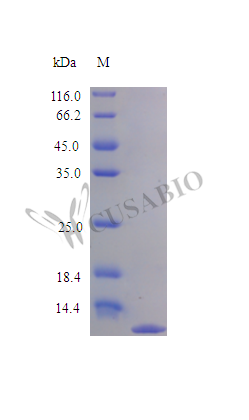Explore the potential of our Recombinant Human CCL8 protein, an essential research tool for immunology-focused investigations. This C-C motif chemokine 8, also known as CCL8, is produced in E. coli and encompasses the 24-99aa expression region of the full-length mature protein. The tag-free protein is supplied in lyophilized powder form, allowing for straightforward reconstitution with sterile water or buffer for a wide range of experimental applications.
Committed to quality and performance, our Recombinant Human CCL8 protein exhibits a purity of >96% as determined by SDS-PAGE and HPLC analysis. Furthermore, endotoxin levels are maintained below 1.0 EU/µg, as determined by the LAL method. The protein demonstrates full biological activity, as determined by a chemotaxis bioassay using human peripheral blood monocytes, with an effective concentration range of 10-100 ng/mL.
Extensive research has been conducted to understand the function and relevance of CCL8 (C-C motif chemokine 8) in various biological processes and diseases. CCL8, a member of the CC chemokine family, was first identified by Van Damme et al. (1992)[1], who elucidated its role as a chemoattractant for monocytes, lymphocytes, and neutrophils. The biological roles of CCL8 in monocyte chemotaxis and immune response were further examined by Gouwy et al. (2011)[2], revealing that CCL8 has unique anti-HIV-1 properties and enhances monocyte migration. CCL8's association with cancer was demonstrated by Hromas et al. (1999)[3], who identified the overexpression of CCL8 in various cancer cell lines and its potential as a prognostic and therapeutic target. The involvement of CCL8 in autoimmune diseases, such as rheumatoid arthritis, was elucidated by Patel et al. (2014)[4], suggesting that CCL8 could serve as a biomarker for this disease. Furthermore, a study by Yin et al. (2016)[5] demonstrated that CCL8 plays a significant role in promoting tumor progression and metastasis in colorectal cancer, providing evidence for its potential as a therapeutic target.
References:
1. Van Damme J, et al. Identification of the human monocyte-derived chemotactic peptide that is identical to monocyte chemotactic protein 2. J Leukoc Biol. 1992;52(6): 595-8.
2. Gouwy M, et al. Unique features of human CCL8: high potency and selectivity for monocytes, and synergistic interactions with monocyte chemoattractant proteins. J Leukoc Biol. 2011;90(6): 1165-74.
3. Hromas R, et al. Cloning of BRAK, a novel divergent CXC chemokine preferentially expressed in normal versus malignant cells. Biochem Biophys Res Commun. 1999;255(3): 703-6.
4. Patel DD, et al. Chemokines in the pathogenesis of rheumatoid arthritis. J Clin Invest. 2014;124(5): 1865-7.
5. Yin X, et al. CCL8 secreted by tumor-associated macrophages promotes invasion and stemness of glioblastoma cells via ERK1/2 signaling. Lab Invest. 2016;96(2): 137-48.




